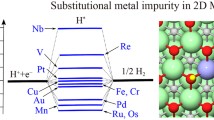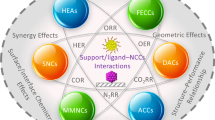Abstract
Bimetallic alloys are increasingly used in heterogeneous catalysis because the synergistic effects between the two metals may create more efficient catalysts. As an example, a dilute amount of Ag within an Au catalyst allows to obtain a low temperature activity together with a large selectivity for selective oxidation reactions. In this context, we present a systematic study of segregations occurring on Au-8.8 at.% Ag samples by atom probe tomography (APT). The samples are prepared as sharp tips representing a single nanoparticle of catalyst. The segregation behaviours are studied by exposing the catalyst to unreactive (Ar), oxidative (O2 and N2O) and reductive (H2) atmospheres at different temperature (323, 373 and 473 K). With a dedicated reaction-cell mounted on the APT system, the exposure conditions are close to the operating conditions of applied formulations of the catalyst. The segregation lead to important surface composition changes, e.g. from Au91.2–Ag8.8 to Ag84–Au16. The obtained results highlight the presence of different Ag segregation behaviours due to surface diffusion after O2 exposure, and due to bulk diffusion after N2O exposure: the different dissociation properties of these two gases explain the different segregation behaviour. Gold segregation was also identified after sample treatments in H2 gas. These results are promising for the engineering of catalysts since it would be possible to design the surface composition by applying different treatments to the sample, therefore allowing a better control on the activity and selectivity of such designed catalysts.
Graphical Abstract









Similar content being viewed by others
References
Ponec V (2001) Alloy catalysts: the concepts. Appl Catal A 222:31–45
Greeley J, Mavrikakis M (2004) Alloy catalysts designed from first principles. Nat Mater 3:810–815
Nørskov JK, Bligaard T, Rossmeisl J, Christensen CH (2009) Towards the computational design of solid catalysts. Nat Chem 1:37–46
Xu J, Ouyang L, Da GJ et al (2012) Pt Promotional effects on Pd-Pt alloy catalysts for hydrogen peroxide synthesis directly from hydrogen and oxygen. J Catal 285:74–82
Peng L, Ringe E, Van Duyne RP et al (2015) Segregation in bimetallic nanoparticles. Phys Chem Chem Phys 17:27940–27951
Barroo C, Bagot PAJ, Smith GDW, Visart de Bocarmé T (2015) Investigating nano-structured catalysts at the atomic scale by field ion microscopy and atom probe tomography. In: Hermans S, de Bocarmé TV (eds) Atomically-precise methods for synthesis of solid catalysts. RSC catalysis series. The Royal Society of Chemistry, London, pp 248–295
Zafeiratos S, Piccinin S, Teschner D (2012) Alloys in catalysis: phase separation and surface segregation phenomena in response to the reactive environment. Catal Sci Technol 2:1721–1996
Baraldi A, Giacomello D, Rumiz L et al (2005) Unexpected behavior of the surface composition of PtRh alloys during chemical reaction. J Am Chem Soc 127:5671–5674
Slater TJA, Macedo A, Schroeder SLM et al (2014) Correlating catalytic activity of Ag-Au nanoparticles with 3D compositional variations. Nano Lett 14:1921–1926
Arve K, Adam J, Simakova O et al (2009) Selective catalytic reduction of NOx over nano-sized gold catalysts supported on alumina and titania and over bimetallic gold-silver catalysts supported on alumina. Top Catal 52:1762–1765
More PM, Nguyen DL, Granger P et al (2015) Activation by pretreatment of Ag–Au/Al2O3 bimetallic catalyst to improve low temperature HC-SCR of NOx for lean burn engine exhaust. Appl Catal B 174–175:145–156
Yen C-W, Lin M-L, Wang A et al (2009) CO oxidation catalyzed by Au–Ag bimetallic nanoparticles supported in mesoporous silica. J Phys Chem C 113:17831–17839
Déronzier T, Morfin F, Lomello M, Rousset JL (2014) Catalysis on nanoporous gold-silver systems: synergistic effects toward oxidation reactions and influence of the surface composition. J Catal 311:221–229
Wongnongwa Y, Namuangruk S, Kungwan N, Jungsuttiwong S (2017) Mechanistic study of CO oxidation by N2O over Ag7Au6 cluster investigated by DFT methods. Appl Catal A 538:99–106
Sandoval A, Aguilar A, Louis C et al (2011) Bimetallic Au–Ag/TiO2 catalyst prepared by deposition–precipitation: high activity and stability in CO oxidation. J Catal 281:40–49
Fujita T, Guan P, McKenna K et al (2012) Atomic origins of the high catalytic activity of nanoporous gold. Nat Mater 11:775–780
Wittstock A, Zielasek V, Biener J et al (2010) Nanoporous gold catalysts for selective methanol at low temperature. Science 80-:327:319–322
Wittstock A, Neumann B, Schaefer A et al (2009) Nanoporous Au: an unsupported pure gold catalyst? J Phys Chem C 113:5593–5600
Takale BS, Feng X, Lu Y et al (2016) Unsupported nanoporous gold catalyst for chemoselective hydrogenation reactions under low pressure: effect of residual silver on the reaction. J Am Chem Soc 138:10356–10364
Guisbiers G, Mendoza-Cruz R, Bazán-Díaz L et al (2016) Electrum, the gold-silver alloy, from the bulk scale to the nanoscale: synthesis, properties, and segregation rules. ACS Nano 10:188–198
Gong HR (2010) Electronic structures and related properties of Ag-Au bulks and surfaces. Mater Chem Phys 123:326–330
Martienssen W, Warlimont H (2005) Springer handbook of condensed matter and materials data. https://doi.org/10.1007/3-540-30437-1
Burton JJ, Machlin ES (1976) Prediction of surface segregation to alloy surfaces from bulk phase diagrams. Phys Rev B 37:1433–1436
King TS, Donnelly RG (1985) Surface compositions and composition profiles of Ag-Au (100), (110), and (111) surfaces determined quantitatively by auger electron spectroscopy. Surf Sci 151:374–399
Wang H, Najafabadi R, Srolovitz D, Lesar R (1993) Interfacial segregation in Ag-Au, Au-Pd, and Cu-Ni Alloys: I. (100) surfaces. Interface Sci 1:7–30
Bozzolo G, Garcés JE, Derry GN (2007) Atomistic modeling of segregation and bulk ordering in Ag-Au Alloys. Surf Sci 601:2038–2046
Barroo C, Montemore MM, Janvelyan N et al (2017) Macroscopic 3D nanoporosity formation by dry oxidation of AgAu Alloys. J Phys Chem C 121:5115–5122
Moskaleva LV, Weiss T, Klüner T, Bäumer M (2015) Chemisorbed oxygen on the Au(321) surface alloyed with silver: a first-principles investigation. J Phys Chem C 119:9215–9226
Barroo C, Janvelyan N, Zugic B et al (2017) Surface modifications during a catalytic reaction: a combined APT and FIB/SEM analysis of surface segregation. Microsc Microanal 22:356–357
Zugic B, Karakalos S, Stowers KJ et al (2016) Continuous catalytic production of methyl acrylates from unsaturated alcohols by gold: the strong effect of CC unsaturation on reaction selectivity. ACS Catal 6:1833–1839
Iizuka Y, Hiragi Y, Yakushiji H, Miura T (2016) An examination of active sites on Au-Ag bimetallic catalysts based on CO oxidation over Au/Ag2O and a comparison to Ag-contaminated Au powder. Chin J Catal 37:1712–1720
Barroo C, Jacobs L, Gilis N et al (2017) Field emission microscopy to study the catalytic reactivity of binary alloys at the nanoscale. Microsc Microanal 23:610–611
Montemore MM, Montessori A, Succi S et al (2017) Effect of nanoscale flows on the surface structure of nanoporous catalysts. J Chem Phys 146:214703 1–8
Cerezo A, Godfrey TJ, Smith GDW (1988) Application of a position-sensitive detector to atom probe microanalysis. Rev Sci Instrum 59:862–866
Miller MK (2000) Atom probe tomography: analysis at the atomic level. Plenum Publishers, New York
Tsong TT (1978) Evaporation fields. Surf Sci 70:211–233
Gault B, Moody MP, Cairney JM, Ringer SP (2012) Atom probe microscopy. Springer, New York. https://doi.org/10.1007/978-3-642-58562-3
Bagot PAJ, Visart de Bocarmé T, Cerezo A, Smith GDW (2006) 3D atom probe study of gas adsorption and reaction on alloy catalyst surfaces i: instrumentation. Surf Sci 600:3028–3035
Visart de Bocarmé T, Moors M, Kruse N et al (2009) Surface segregation of Au-Pd alloys in UHV and reactive environments: quantification by a catalytic atom probe. Ultramicroscopy 109:619–624
Morita M, Karasawa M, Asaka T, Owari M (2014) The Analysis of metal catalyst nanoparticle by atom probe tomography. e-J Surf Sci Nanotechnol 12:145–148
Barroo C, Magyar AP, Bell DC (2015) Catalysis and atom probe tomography: recent progresses and future developments towards the analysis of nanoporous samples. Microsc Microanal 21:855–856
Barroo C, Moors M, Visart de Bocarmé T (2017) Imaging and chemical probing catalytic processes using field emission techniques: a study of NO hydrogenation on Pd and Pd–Au catalysts. Catal Sci Technol 7:5249–5256
Barroo C, Gilis N, Lambeets SV et al (2014) Oxygen assisted reconstructions of rhodium and platinum nanocrystals and their effects on local catalytic activity of hydrogenation reactions. Appl Surf Sci 304:2–10
Personick ML, Zugic B, Biener MM et al (2015) Ozone-activated nanoporous gold: a stable and storable material for catalytic oxidation. ACS Catal 5:4237–4241
Wang L-C, Stowers KJ, Zugic B et al (2015) Exploiting basic principles to control the selectivity of the vapor phase catalytic oxidative cross-coupling of primary alcohols over nanoporous gold catalysts. J Catal 329:78–86
Smithells CJ, Brandes EA (1977) Metals reference book, 5th edn. Butterworth, London
Yabumoto M, Watanabe K, Yamashina T (1978) An AES study of surface segregation of Ag-Au alloys with ion bombardment and annealing. Surf Sci 77:615–625
Visart de Bocarmé T, Chau TD, Tielens F et al (2006) Oxygen adsorption on gold nanofacets and model clusters. J Chem Phys 125:1–7
Tan SA, Grant RB, Lambert RM (1987) The silver catalysed decomposition of N2O and the catalytic oxidation of ethylene by N2O over Ag(111) and Agalpha-Al2O3. J Catal 104:156–163
Scholten JJF, Konvalinka JA, Beekman FW (1973) Reaction of nitrous oxide and oxygen with silver surfaces, and application to the determination of free-silver surface areas of catalysts. J Catal 28:209–220
Angelidis TN, Tzitzios V (2003) Promotion of the catalytic activity of a Ag/Al2O3 catalyst for the N2O+CO reaction by the addition of Rh a comparative activity tests and kinetic study. Appl Catal B 41:357–370
Tzitzios VK, Georgakilas V (2005) Catalytic reduction of N2O over Ag–Pd/Al2O3 bimetallic catalysts. Chemosphere 59:887–891
Bagot PAJ, Cerezo A, Smith GDW (2008) 3D atom probe study of gaseous adsorption on alloy catalyst surfaces III: ternary alloys—NO on Pt-Rh-Ru and Pt-Rh-Ir. Surf Sci 602:1381–1391
Li T, Bagot PAJ, Marquis EA et al (2012) Characterization of oxidation and reduction of Pt-Ru and Pt-Rh-Ru alloys by atom probe tomography and comparison with Pt-Rh. J Phys Chem C 116:17633–17640
Li T, Bagot PAJ, Marquis EA et al (2013) Atomic engineering of platinum alloy surfaces. Ultramicroscopy 132:205–211
Gluhoi AC, Dekkers MAP, Nieuwenhuys BE (2003) Comparative studies of the N2O/H2, N2O/CO, H2/O2 and CO/O2 reactions on supported gold catalysts: effect of the addition of various oxides. J Catal 219:197–205
Zeiarnik AV (2003) Adsorption and reactions of N2O on transition metal surfaces. Kinet Catal 44:250–265
Jacobs L, Barroo C, Gilis N et al (2018) Structure reactivity relationships during N2O hydrogenation over Au-Ag alloys: a study by field emission techniques. Appl Surf Sci 435:914–919
Wang L-C, Personick ML, Karakalos S et al (2016) Active sites for methanol partial oxidation on nanoporous gold catalysts. J Catal 344:778–783
Deng X, Min BK, Guloy A, Friend CM (2005) Enhancement of O2 dissociation on Au(111) by adsorbed oxygen: implications for oxidation catalysis. J Am Chem Soc 127:9267–9270
Tielens F, Andrés J, Chau TD et al (2006) Molecular oxygen adsorption on electropositive nano gold tips. Chem Phys Lett 421:433–438
Liu X, Li Y, Lee JW et al (2012) Selective hydrogenation of acetylene in excess ethylene over SiO2 supported Au-Ag bimetallic catalyst. Appl Catal A 439–440:8–14
Okada M, Nakamura M, Moritani K, Kasai T (2003) Dissociative adsorption of hydrogen on thin Au films grown on Ir {111}. Surf Sci 523:218–230
Gatin AK, Grishin MV, Gurevich SA et al (2014) Interaction of hydrogen and oxygen on the surface of individual gold nanoparticles. Russ Chem Bull Int Ed 63:1696–1702
Corma A, Boronat M, González S, Illas F (2007) On the activation of molecular hydrogen by gold: a theoretical approximation to the nature of potential active sites. Chem Commun 32:3371–3373
Acknowledgements
L.J. and C.B. thank the Fonds de la Recherche Scientifique (F.R.S.-FNRS) for financial support: PhD Grant from FRIA (L.J.) and postdoctoral fellowship from FNRS (C.B.).
Author information
Authors and Affiliations
Corresponding author
Rights and permissions
About this article
Cite this article
Gilis, N., Jacobs, L., Barroo, C. et al. Surface Segregation in Au–Ag Alloys Investigated by Atom Probe Tomography. Top Catal 61, 1437–1448 (2018). https://doi.org/10.1007/s11244-018-1040-0
Published:
Issue Date:
DOI: https://doi.org/10.1007/s11244-018-1040-0




